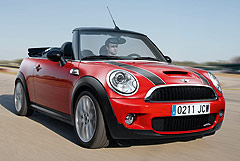BMW power for Saab’s next 9-3
BY MARTON PETTENDY | 30th Sep 2010

Although neither car-maker has specified which version of the British-built turbo-four will be used by Saab – or which model it will power – European reports state the most powerful 155kW engine seen in the flagship Mini JCW will be followed by other variants of the N18 engine, probably including the 128kW version in the Cooper S and, later, E85-compatible derivatives in line with Saab’s ethanol engine focus.

Saab says the engines, which will come standard with fuel-saving idle-stop and regenerative braking systems, will be adapted to meet its specific requirements for use in a range of next-generation models, the first of which will be the redesigned 9-3 mid-sizer in two years.
Later, the BMW-Mini engine could also power Saab’s next large 9-5 range-topper - due around 2015 - and, if it eventuates, the all-new ‘92’ compact car now under consideration by the former General Motors brand.
A group of BMW and Saab engineers has reportedly already been formed to work on the integration of Saab’s next-generation chassis with the BMW engine.
Autocar reports that some 200,000 BMW engines will be supplied over the lifespan of the next 9-3, although both companies say they have agreed not to disclose any financial or contract volume details.
It is not clear if the deal will spell the end of exports of V6 engines from GM Holden to Saab, which has said it wants a variety of suppliers in the future and is also expected to announce a diesel engine supply deal soon.
The company that was rescued from its death under GM ownership by Spyker will stage the world debut its 9-4X crossover at the Los Angeles motor show in November.
Like the Cadillac SRX upon which it is based – and alongside which it will be built by GM in Mexico – the 9-4X will be powered exclusively by the Holden-made turbocharged 2.8-litre V6.
Saab Automobile CEO Jan Åke Jonsson announced the deal on Wednesday (September 29) at Saab’s Trollhattan base 70km north of Gothenburg.
“BMW’s engines and their fuel savings innovations are widely regarded as a benchmark in the premium segment,” he said. “We look forward to integrating this technology into our next-generation vehicles in a true Saab way.”Saab chairman and Spyker stalwart Victor Muller said the deal could lead to further synergies between Saab and BMW.
Both companies have stated they are exploring new ways to share vehicle platforms with other car-makers, including the new 92 in Saab’s case and the next-generation Mini and next-generation (front-drive) 1 Series in BMW’s case.
“This is a major step forward for Saab on our journey to becoming a profitable independent premium car maker,” said Mr Muller.
“In line with our strategy, we will continue to capitalise on our own engineering expertise while also working with the very best partners. This relationship will enable both parties to explore further opportunities in the future.”BMW AG board member for sales and marketing Ian Robertson said the deal was part of the Bavarian maker’s push to increase sales of its engines globally.
“As part of our ‘Strategy Number One’ we are continuing to expand our powertrain sales business worldwide,” he said.
“Today’s agreement marks another important milestone along this route. Our engines have a clear lead over the competition when it comes to fuel consumption, emissions and performance and we are delighted to support Saab with our engine expertise.”Saab’s future in Australia continues to remain unclear following its sale by GM to Spyker and the subsequent relinquishment of GM Holden’s distribution rights in Australia.